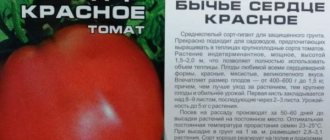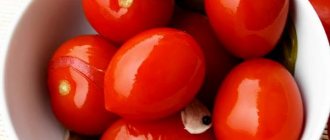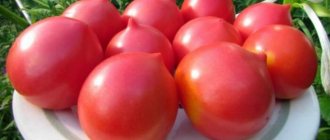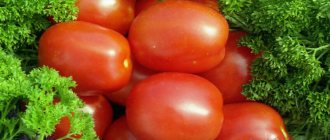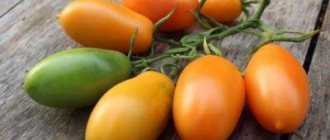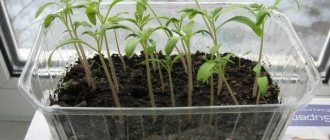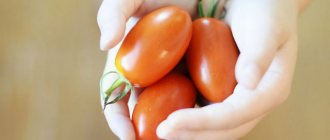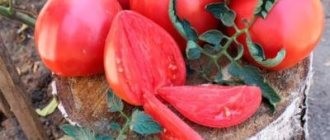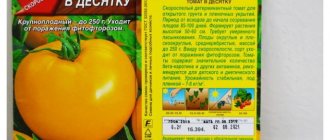The pepper tomato looks like a bell pepper pod. The fruits differ in size, weight, and color. Varieties are selected for greenhouses and open areas according to ripening time.
Pepper tomatoes have thick walls, which allows them to retain moisture for a long time and not crack during heat treatment. They are stored for a long time and can be preserved. What varieties do gardeners grow? Which tomato to choose?
Pepper-shaped
The originator of the variety is (Moscow region). The bush is tall, powerful, indeterminate type. There is no growth point; in greenhouses the plant reaches 1.8-2 meters.
The tomato is mid-season, the fruits are ready for harvesting after 110-115 days. The shape of the tomatoes is a cylinder, with slight ribbing. Some unripe fruits have a green spot near the stalk; the tomatoes themselves are light green; when ripe, they are bright red. The weight is small, 80-100 grams, although there are larger specimens.
The pulp is fleshy, inside there are two chambers with a small number of seeds. The walls are dense, which makes them suitable for preparing stuffed dishes. The taste is good, the use is universal.
Productivity
Pepper-shaped tomatoes are classified as mid-season varieties; the fruits begin to ripen 110–115 days after germination. The first tomatoes grown in open soil should be expected only by the beginning of July, and the last harvest will have to be harvested by the middle or end of September. If you grow plants in greenhouse conditions, they will begin to bear fruit with the onset of summer, and this cycle will last until the beginning of September.
Important. In August, it is imperative to pinch the top of each bush, otherwise the emerging inflorescences will not be able to begin to bear fruit on time.
The height of bushes belonging to the indeterminate species reaches on average one and a half to two meters, and therefore all such varieties require supports and pinching. Each cluster can bear from 6 to 10 fruits. About a bucket of harvest is harvested per square meter - up to nine kilos of tomatoes.
Pepper varieties do not require much effort from the gardener; they are easy to grow even for a novice amateur. The main thing when growing is to follow all the rules for caring for the plant.
The plants are very productive, some grow up to two meters in height, so they require obligatory staking.
Yellow
In 2007, two interesting tomatoes appeared in the State Register, including Pepper Yellow.
The tall indet impresses with the power of the plant and its large dark green leaves. The foliage is small, the stem height is 1.7-1.9 meters.
After 115-117 days, the first tomatoes are harvested. This variety is suitable for greenhouses and open ground. Leave one trunk, removing all side shoots. In terms of yield, the indicators are not particularly high - up to 3-3.5 kg per square meter, but this variety is valued for the excellent taste of the fruit.
The inflorescences are simple, the fruits are similar to their “brother” - the red pepper tomato. Their walls are dense, and there are small ribs on the surface. The color is bright yellow.
Peculiarities:
- Wonderful taste;
- drought resistance;
- resistance to TMV, various types of rot;
- long fruiting period.
The tomato is demanding of good lighting and soil fertility. The originator is the famous breeder L.A. Myazina. Tomatoes are used in salads, ideal for canning and pickling.
Growing rules
A good harvest can only be obtained from high-quality seed material
Large-fruited pepper-shaped tomatoes require compliance with certain rules that help to obtain a bountiful harvest, and under favorable conditions, increase its quantity. The main nuance when growing hybrid varieties is the choice of high-quality seed.
Seeds must be purchased from those organizations that have patented the creation technology and provide certified material. When purchasing from an untrusted place, there is a risk of purchasing a low-quality product that will reduce the yield or not sprout at all.
Sowing seeds for seedlings
Seeds for seedlings begin to be sown in the first month of spring. In this case, the days are selected taking into account favorable lunar phases. The land is prepared in advance or a nutrient substrate is purchased. You can prepare it yourself by mixing turf soil, humus, and sand. Superphosphate (2 tbsp) and ash (5 tbsp) are also added to the soil mixture.
The prepared container (wooden box) is filled with substrate. Draw long stripes with a pencil and lay out the seeds (they do not require pre-treatment) at a distance of 3 cm from each other, then sprinkle them with earth. Moisten, cover with film and send to a warm place (25 ° C) until shoots appear.
Next, the film is removed and the container is moved to a well-lit place.
At the stage of formation of 2-3 leaves, the seedlings are planted in peat pots, which are filled with a substrate similar in composition to the original one. 14 days before planting in open ground, seedlings begin to be hardened by exposing them to the air. The time spent outside is increased from 30 minutes. until 8 o'clock
Transplantation into open ground
Pepper tomatoes are not planted in areas where potatoes used to grow. Choose a place with fertile, non-acidic soil. The soil is fertilized with compost in the fall. Before planting, the beds are cleared of weeds, dug up and leveled with a rake.
- dig holes (no more than 4 per 1 m²);
- the bottom is covered with superphosphate and moistened;
- place the seedlings in the holes together with a ball of earth so as not to damage the roots;
- cover with earth and lightly compact;
- plantings are watered.
The characteristics of hybrid plants indicate that they are undemanding in care, but the standard rules should be followed carefully, because compliance with them directly affects productivity.
Basic care recommendations:
- watering. Low-growing pepper tomatoes are moistened when planted in open ground, 7-10 days after planting, during the formation of the ovary and at the end of June. Tall varieties require frequent watering, which is carried out on average 1-2 times every 7 days (depending on weather conditions);
- feeding The primary application of fertilizers (manure or chicken droppings) occurs 10 days after planting, the secondary application - during the period of active flowering (wood ash);
- stepsoning. Tomato bushes require proper formation, as well as the removal of side shoots until they reach 5 cm.
Orange
The orange pepper tomato is distinguished by the original color of its fruit, which is also valued for its high yield (up to 9-10 kg per square meter). In the State Register of the Russian Federation - since 2007.
Belongs to the type of indeterminate tomatoes, the bush is vigorous and tall (up to 1.8 meters). In Siberia and other harsh regions it is planted in shelters; in the south it bears fruit well in ridges. The best option is to use it in a shelter to support a trellis. Grow the Orange bush in 1-2 stems, tying the clusters when the fruits ripen on them.
Quite large fruits weigh 150-170 grams; when growing the plant without additional stems, tomatoes weigh up to 280-300 grams. The skin is dense, but without rigidity, the flesh is fleshy and tender. The taste of the tomato is excellent. The use is universal, and this is also one of the advantages of Pepper Orange.
The “advantages” of the variety include:
- unpretentiousness;
- low susceptibility to disease;
- long fruiting.
Judging by reviews from gardeners, Orange’s fruits are suitable for canning as a whole. They look beautiful mixed with green cucumbers, red and yellow tomatoes.
Unusual varieties of tomatoes
The next two varieties have interesting, very characteristic banana-shaped fruits. The tomatoes are dense, but somewhat dry - because of this, the taste of fresh fruit is not too rich. But the preparations turn out excellent.
Tomato Auria
Tall, mid-late productive variety. A description of the Auria tomato is given as a liana-like plant, reaching 2 m, which grows into 2 stems. Relatively thin, not powerful shoots require timely garter. The clusters with fruits are large – up to a dozen, less often – up to 20 fruits. Of these, 4-5 are large, the rest are medium and small. The average length of the fruit is 12-14 cm. The average weight is 60-80 g, can reach up to 150 g.
Tomatoes of the Auria variety are distinguished by their characteristic shape - elongated fruits with a slightly forked end. Fleshy, with two seed chambers with a few small seeds evenly spaced along the fruit.
The description of the variety defines the taste qualities that the Auria tomato has as freshish, even rather dry.
The reviews left about the Auria tomato emphasize the excellent taste of preparations made from it. Thus, the paste does not need to be boiled for a long time, since the fruit does not contain too much water, and it turns out tender and sweet. And whole fruits are conveniently placed in jars and do not crack.
Tomato Eros
An absolute analogue of Auria, repeating the original shape of its fruits - the same elongated, forked at the end. The difference is in color - if Auria is red, then tomatoes of the Eros variety are orange, and they are somewhat smaller.
The variety is mid-season, ripens in 111-115 days. Resistant to various diseases. The bush is vigorous, up to 1.8-2 m. Formation of 3 stems is preferable. The variety is super-yielding. The clusters contain 5-7 fruits, sometimes up to 10, up to 150 g in weight.
The dense fruits are bright orange in color, contain few seeds (occasionally they are slightly hollow), and are resistant to overripening and cracking. Universal - good both raw and for whole-fruit canning. The fruits are stored for up to 2-3 weeks. Look at the article: Black tomatoes: the best varieties, their brief quality characteristics.
Giant
2007 is the time when the Pepper-shaped giant tomato appeared in the State Register.
The characteristics and description of the variety are identical to the tomatoes described above, the differences lie in the configuration of the fruit and color. The Giant's tomatoes are slightly elongated, deep red in color, weighing up to 200 grams. 1-2 stems are left on the bushes; pinching is required. The clusters produce 5-9 fruits, the total yield is 5.5-6.5 kg per square meter.
The skin is hard and glossy. Fruits with dense fleshy pulp, 3-4 chambers inside, few seeds. The taste of tomatoes is good, this is noted by everyone who planted the Pepper-shaped Giant on their plot.
Where to use tomatoes? In salads, they are also tasty when pickled or preserved. Housewives freeze and dry it, and use it for stuffing.
"Scarlet Mustang"
Belongs to indeterminate varieties, carpal. The features of the hybrid are as follows.
- Seedlings are planted two months before planting in the soil. It is better to plant four bushes per square meter.
- There are few leaves on the bush, their height ranges from one to three meters. It is recommended to leave a couple of stems of each plant.
- The fruits have an elongated pepper-shaped shape, the length ranges from 10 to 18 cm. When ripe, they take on a red-crimson color. Weight is about 200 g, the flesh is fleshy and pleasant to the taste.
Tomatoes of this hybrid are suitable for eating and canning, and in jars they look very elegant.
The fruits of this hybrid become red-crimson when ripe with a pleasant-tasting fleshy pulp.
Sturdy
In 2014, the catalog of the State Register was replenished with a new tomato from Altai breeders - Pepper-shaped robust. From all his “relatives” already registered on the list, he stood out in height. Tomato: Pepper-shaped, robust, determinate type, no more than 30-40 cm in height.
The bushes are compact, with little foliage; plant shoots are not removed. But remember that a tie to the support in the beds is required, since the branches break off under the weight of the fruit. Yield indicators are up to 4-4.5 kg per square meter. The first pepper tomatoes are harvested after 105-107 days.
The fruits are elongated, weight – 120-140 grams, there are three chambers inside. There are few seeds. The color of the skin in a state of technical ripeness is green, when ripe it is dark crimson. Some fruits have a dark burgundy spot near the stalk.
Gardeners note the excellent taste, which, however, is typical for all tomatoes in this group. The fruits are suitable for pickling, winter salads, and for processing. The “advantages” of Krepysh include:
- compactness of plants;
- disease resistance;
- unpretentiousness;
- good tomato taste.
The variety is good for Siberia, the North-West, and the Urals, where the warm season is short and the summer is often cool.
"Sparks of Flame"
The variety is mid-late, famous for its high yield. It belongs to the indeterminate species and can grow indefinitely. It is grown mainly in greenhouses. The best result is achieved by leaving only 2 stems.
The characteristics of the fruit are as follows:
- have elongated, up to 13 cm, fruits, somewhat reminiscent of plums with a pointed “spout”;
- after full ripening they acquire a red color with golden sinuous stripes (this color, by the way, is their main feature);
- weight ranges from 150 g;
- the taste is juicy and rich;
- The pulp is fleshy, there are few seeds.
The variety has become popular among gardeners due to its high yield, excellent taste and unusual coloring, similar to tongues of fire.
Seeds for seedlings need to be sown 60 - 65 days before planting in the greenhouse. It is recommended to place up to three bushes on each “square”.
Red
In 2015, the Pepper-shaped Red (agro) variety was registered in the State Register. The plant reaches a height of almost two meters, has long leaves, and forms complex inflorescences. In terms of timing, it is a mid-season tomato, which is quite suitable for both the middle zone and the northern regions. Pepper-shaped tomatoes, with a ribbed surface, look like red sweet peppers. Weight – 120-150 grams.
Description of tomatoes: ripe fruits of bright red color, glossy, dense skin. The pulp is fleshy, the number of chambers is 3-4. The taste of tomatoes is excellent, with good yield indicators - up to 2.5-3 kg per bush. Like many other tomatoes with fruits and peppers, Red is used for canning, pickling, and eaten fresh.
"Illusion"
This hybrid belongs to the indeterminate mid-season varieties. The bushes grow up to one and a half meters and have regular foliage. The initial inflorescence is formed above the ninth leaf, and then at intervals every three leaves.
Tomatoes are cube-shaped with a slightly ribbed surface. When ripe, they acquire a yellow color. Externally, tomatoes are a little similar to the fruits of the Novogoshary variety of sweet peppers. Approximate weight - from 150 to 200 grams.
Most often, Illusion tomatoes are stuffed, baked or stewed, as they “hold” their shape well. The pulp of the walls is dense, the core separates freely.
Crimson
The variety from Siberian breeders called Pepper Raspberry is intended for cultivation in the open air. You can plant it under shelters; arcs or greenhouses are suitable. The beautiful fruits are suitable for all types of processing, tasty fresh and in pickles.
The tomato is a determinate type, low, reaching a height of 40-50 cm in the garden. The fruits are both similar to sweet peppers and elliptical, with a very smooth glossy skin of raspberry-purple color.
Inside the fruits there are 4-6 nests, there are few seeds. The weight of tomatoes reaches 150 grams, but with special care you can grow fruits up to 250 grams. The pulp is fleshy, sugary, pleasant taste.
Variety value:
- early ripeness (100-102 days);
- excellent taste of tomatoes;
- good yield indicators (up to 8 kg per square meter in beds, up to 15 kg in greenhouses);
- resistance to cold weather.
Tomato varieties from Siberian breeders are adapted to harsh local conditions, and they will delight you with abundant fruiting and good taste.
Reviews from gardeners
anastasia
I planted red pepper from sedek. Nothing fresh yet. The pickling is disgusting, tasteless, wooden ass.
Source: www.tomat-pomidor.com
tomatinka
I have been planting Cuban black for three years. Since I grow it in the exhaust zone, the height of the bush is about a meter. Productivity is good. The fruits are shaped like peppers. Elongated, dark brown. The taste is ordinary. I like it better in marinades.
Source: www.tomat-pomidor.com
Pink
The originator of the variety is a well-known agricultural company that supplies seeds of a wide variety of tomatoes to the market. The variety also produces seeds. Pepper pink was registered in the State Register in 2018, so it can be called a new product.
The bushes are tall (up to 1.6 meters), with medium foliage. Stepchildren are removed from the plant and must be formed. Most often, two stems are left (this results in higher yields).
Tomatoes are elongated, with a miniature “tail”. The pink skin is dense, but thin, with a shine. The weight of the fruits is equal, approximately 80-100 grams. Those who have already grown the variety note its balanced taste and aroma. The tomato is a mid-season variety, the first fruits are harvested after 105-110 days, the average yield is 6-7 kg per square meter.
"Banana"
Refers to mid-early hybrids, ripening period is 105 days from emergence.
Bushes in greenhouse conditions grow up to 1.5 m. Experts recommend forming plants into two or three stems.
When tomatoes ripen, they turn red. Their weight ranges from 80 to 120 grams, the flesh is fleshy and pleasant to the taste.
The cultivation technology is as follows.
- For seedlings, seeds are planted in March-April, planting depth is one centimeter.
- Picking begins at the stage of the appearance of a pair of full-fledged leaves.
- A week or a little more before planting (and you need to plant 60-day-old seedlings), they begin to harden them.
- Planting dates - for greenhouses: April - May, for open ground: June, when the threat of spring frosts has passed, at the stage of 6-7 full leaves. Planting pattern: 30 x 50 cm.
- Plants need to be watered regularly.
- During the entire growing season, two or three feedings will be needed.
Striped
For lovers of original varieties, we recommend the Striped Pepper tomato. Its fruits are red-orange with golden shading, great for salads and canning.
The plant is low (up to 60-70 cm), squat, heavily leafy. Due to its compactness, tomatoes are planted densely in beds, up to 7-8 plants per square meter. meter.
Typically, this tomato is formed into 3-4 stems, since the main stem quickly completes the growth of a flower cluster. Each bush bears 4-5 clusters, each containing up to 8 fruits.
In terms of productivity, this variety is inferior to other pepper tomatoes, but it has a different value - the unusual color of the fruit.
According to reviews, the taste of tomatoes of the Striped Pepper variety is good, but there are voids in the pulp. This canned tomato is great; the preparations look elegant. It does not lose its shape in marinades and brine, and the skin does not crack.
"Kasady's Folly"
In various catalogs, this variety is also called “Kasady’s Madness” and “Kasady’s Recklessness.” It is classified as a mid-early semi-determinant carpal hybrid.
The main feature of the hybrid is its elongated fruits with original golden stripes.
Seeds are sown for seedlings two months before planting in a permanent place. It is recommended to place four plants on one square.
The height of the bushes is average, up to 1.4 m, in open soil – lower, about a meter. It is recommended to organize seedlings in 3 - 4 stems.
The fruits are elongated, dense and beautiful in appearance. When tomatoes ripen, they acquire a red color, decorated with a golden sinuous stripe. Weight ranges from 60 to 140 grams. The taste is pleasant. Tomatoes do not crack during storage or transportation. There are few seeds in the pulp.
Cuban
This variety is not included in the State Register, which in no way detracts from its value. In catalogs of tomato collectors, Cuban is found under other names: Pepper-shaped black, Cuban black. Those who prefer large-fruited tomatoes should not miss this variety.
The most attractive thing is the fruits, large, weighing up to 300-350 grams and very similar to juicy sweet peppers. The dense skin is dark red, almost black at the stalk, the flesh is fleshy, there are very few seeds.
Everyone who planted the variety speaks positively about the taste of these tomatoes. It is not suitable for preparations; the best use is fresh and in salads. The plants are tall, reaching 2.2-2.4 meters in shelter. The bushes must have stepsons, leading the plants into two stems, leaving an additional stepson.
ON A NOTE! This tomato is medium late, so in regions with harsh climates it is grown only in greenhouses.
For 1 sq. 2-3 bushes are placed per meter. It takes a long time to bear fruit, and what is important is that the tomato is resistant to infections.
Varieties
The pepper type of tomatoes includes several hybrid varieties, which are represented by low- and tall-growing plants with increased resistance to most existing diseases. Tomatoes bear fruit abundantly in open ground and greenhouses.
Breeders have created a variety of varieties to satisfy the need of even remote regions for abundantly fruiting tomatoes. Varieties with yellow and red fruits are especially valued, as they bring the greatest harvest.
Tatyana Orlova (Vasilidchenko) (candidate of agricultural sciences):
The biological type of tomato has 3 subspecies:
- Cultivated - as a rule, the fruits are round or flattened, quite large.
- Semi-cultivated - the fruits have a pear-shaped, plum-shaped, elongated shape. The fruits are medium in size.
- Wild - (currant, racemose) - the fruits are small, slightly larger than nightshade.
Pepper tomatoes were obtained by breeders using a semi-cultivated subspecies.
A mid-season variety that is ready for consumption 115 days after planting the seeds for seedlings. Fruiting begins in the second decade of July and ends no later than the end of September. The striped variety of tomatoes is suitable for open ground (grows up to 1 m) and greenhouses, in which the bush reaches 120-130 cm.
The bushes are strong, with a lush aboveground part. The leaves are dark green. Plants form 5-6 clusters, which bear 8 to 10 fruits. Greenhouse specimens are grown in one stem, in open ground - in 2-3 stems, which are tied so that the shoots do not break under their own weight.
The fruits look similar to peppers. They are characterized by a cylindrical, elongated (up to 15 cm) shape, and the weight reaches 120-160 g. The striped tomato is dense, smooth, and has a red-yellow tint that resembles the color of a tiger. The pulp is juicy, dense, fleshy and tender.
The striped pepper tomato is resistant to most diseases characteristic of this crop. Calmly tolerates temperature changes, direct sunlight and light watering.
Fruiting is abundant: at least 7 kg of tomatoes are harvested from one bush of this variety, and if agricultural practices are followed, the yield reaches 10 kg. Tomatoes can be eaten fresh and used for winter preparations, especially canning in their entirety.
The prototype for the creation of this variety was the American tomato Banana Legs. The mid-early crop bears fruit in open ground and greenhouses. The height of the bush is 120 cm, sometimes reaching 150-180 cm. The leaves are sparse, dark green. The yellow-fruited variety has a simple type of inflorescence.
A distinctive characteristic of this variety is the formation of small, even, cylindrical fruits. Tomatoes ripen in batches of 6. on one hand and weigh at least 70 g each. Harvesting begins when the fruit turns yellow. The tomato pulp is juicy and aromatic.
The yellow pepper tomato is resistant to fungal diseases, temperature changes and drought, but prolonged cold spells cause the vegetation process to stop. In regions with late spring frosts, planting in the ground is postponed until temperature levels stabilize.
The yellow-fruited tomato variety brings from 3 to 6.5 kg of yield per bush, subject to all care requirements. The fruits are suitable for salads, winter preparations (canning and pickling).
Orange pepper tomato is an early-ripening greenhouse variety that is not adapted to open ground due to the threat of late frosts. The fruits ripen 90 days after sowing the seeds for seedlings.
The height of the bush of the indeterminate variety is 1.5-1.8 m. The branched plant is prone to the formation of numerous stepsons. The leaves are medium sized, light green in color. A bush with sparse intermediate inflorescences that bear up to 6 fruits on one cluster.
The length of the fruit is up to 15 cm, the average weight of one tomato reaches 150-200 g. The skin is thick and has a bright orange tint. The fruit has soft, juicy pulp and 3-4 seed chambers.
Plants are resistant to diseases, but do not tolerate temperature changes, which stop growth and fruiting. An early-ripening variety produces up to 5-6 kg of tomatoes from one bush, which are consumed fresh or canned. Orange pepper tomato is rich in carotene and vitamin C, so it is suitable for tonic juices in winter.
The Krepysh variety is distinguished by early fruiting
The pepper tomato Krepysh was created specifically for the climate of Siberia, where the warm season is limited. It was bred for cultivation in open ground conditions. Early ripening variety: fruiting occurs 110 days after the appearance of the first shoots.
The standard plant reaches only 0.4 m in height, it is undemanding in terms of pinching and tying. The culture received this name due to the large size of the bush.
The fruit is cylindrical in shape, with a dense skin, which at the ripe stage acquires a pink tint. A characteristic feature is a small greenish spot near the stalk. The tomato pulp is juicy.
Low-growing plants are adapted to growing in any climate zone, since they were bred specifically for cold regions with low light. They are resistant to most known diseases.
The fortress is a medium-yielding species. No more than 4 kg of fruits are collected from one bush per season. Tomatoes are used for salads, canning, making juices, tomato sauces, etc.
The Cuban black subspecies is classified as a mid-season variety, since the first fruits are harvested 120 days after sowing. Culture does not stop growing on its own. Greenhouse specimens reach 3 m, and those grown in open ground - 150 cm.
The Cuban tomato requires obligatory pinching and tying, otherwise the plant will not support its own weight.
The bush is well leafy, with regular leaves and a powerful stem. Plants are formed into several stems, which increases productivity. The fruits are massive, pepper-shaped and reach 200-350 g. Cuban fruits are collected from the garden when the skin turns burgundy color. The tomato pulp is juicy and fleshy.
A description of the species will be incomplete without mentioning its resistance to various diseases and pests: late blight, spider mites. The Cuban pepper tomato is a high-yielding variety that produces up to 7 kg of fruit from one bush, and when grown in 2-3 stems, these figures reach 10 kg. Tomatoes are consumed fresh or stored for the winter.
Royal
This variety of pepper tomatoes can be grown both in open ground and in a greenhouse. You need to purchase seeds from. Otherwise, you can get a poor harvest that does not meet the declared characteristics.
The royal tomato is classified as a mid-season species that begins to bear fruit on the 107th day after germination.
This is an indeterminate plant, the height of which is more than 1.7 m. The bush is sparsely leafed, with leaves typical of tomatoes. The fruits are small, oblong, the average weight reaches 85 g. Tomatoes are ready for harvesting when they acquire a bright red hue. The skin is dense and resistant to cracking. The pulp is fleshy, juicy, and has a sweet taste.
The hybrid is resistant to common diseases, tolerates transportation well and has a long shelf life. The tomato produces a bountiful harvest, which is excellent for fresh consumption and pickling.
Minusinsky
The fruits are used to make juices
The vegetable crop is suitable for cultivation in different regions, but in areas with harsh climates it must be cultivated in specialized greenhouses. The mid-season variety produces a harvest 110-112 days after the first shoots appear.
The Minusinsk long variety forms bushes of at least 2 m with few leafy shoots. The main feature of the vegetable crop is its weak stem, which requires additional support. The plant is tied using fabric tapes to stakes that are driven in next to the stem.
Variety of originals
Our review shows tomato varieties with pepper-shaped fruits that are in demand and known to summer residents. But this list is not final, since other varieties of this group have been bred and successfully grown.
Not so long ago, in 2015, a very productive hybrid Peter the Great F1 (agro) was included in the State Register, the fruits of which are ideal for winter harvesting (preservation, pickling).
Among the raceme tomatoes, the Chukhloma variety is known (yield up to 6 kg per 1 square meter). Popular ones include the beautiful indet Scarlet Mustang, mid-season Roma, as well as the original Italian spaghetti variety with raspberry, elongated tomatoes.
For preservation, you cannot find better varieties than Auria (red tomatoes) and Eros (orange), as well as the magnificent Banana Legs (yellow-colored fruits). Judging by the reviews, the fresh fruits of these varieties are not so tasty, but when preserved and pickled, they turn out simply great.
The group of pepper tomatoes includes different varieties grown by summer residents in all regions of the country. For areas with short summers, tomatoes from Siberian breeders are suitable, for the south - tall indeterminate tomatoes that bear fruit well in open ground. We hope that our review will allow you to understand all the diversity, find “your” options and get a good harvest of delicious tomatoes!
Natalia Severova
Subtleties of cultivation
Proper care will have a positive effect on plant productivity
Hybrid varieties of tomatoes are grown in a greenhouse not by seeds, but by seedlings. The advantage of this variety of vegetable crop is that the purchased seeds are already prepared for planting and do not require additional processing, showing good germination.
Among the main conditions for sowing hybrid tomato seeds is compliance with the required temperature regime at a level of at least 25°C. The depth at which it is recommended to sow seed material in a greenhouse is no more than 1 cm.
The picking procedure for pepper varieties is not much different from that used for traditional tomatoes. It is carried out when 2 leaves appear on the sprouts. Pepper tomatoes are transplanted into open ground in May, maintaining a planting frequency of no more than 4 seedlings per 1 square meter. m of sown area.
Further care
Caring for varieties of pepper tomatoes involves proper watering, fertilizing and pinching of tomato bushes, which certainly affects the yield of vegetables.
Watering tomatoes is required according to the rules, depending on the variety:
- for low-growing varieties, which include standard species, watering is carried out immediately after transplanting the seedlings into open ground, repeated after 20 days, then after flowering and then at the end of June,
- for tall species, more frequent watering is required: during dry periods - at least 3 times a week; in some cases, gardeners dig a trench near the garden bed, into which water is periodically poured.
It is recommended to fertilize pepper tomatoes with manure or chicken droppings. Feeding is done 1 month after planting the seedlings in open ground, when the plant puts out lateral roots.
If the tomato foliage looks dry, apply nitrogen-containing fertilizer complexes. If Pepper tomatoes are gaining weight too actively, they lack phosphate bait.
Pepper tomatoes, characteristics and application.
Pepper tomatoes are used for everything:
- They are useful to eat fresh;
- They make excellent preservation;
- fruits are recommended for stuffing, since tomatoes have a dense structure and do not fall apart during cooking;
- When stored properly, tomatoes do not lose their taste and even smell for a long time;
- Due to the higher concentration of sugar in the fruits of these hybrids than other varieties, they are often used to prepare food for children, as well as tomato juices and purees.
We invite you to familiarize yourself with: Tomato Timiryazevets characteristics and description of the variety
Several types are in greatest demand in our country. Let's give them a brief description.
Pepper tomatoes are used in various forms:
- The variety is good for fresh consumption, as well as for rolling for the winter.
- Pepper-shaped tomatoes are perfect for stuffing, as they are dense, do not fall apart when cooked, and their taste and aroma are preserved.
- Due to the fact that tomatoes of the described variety contain more sugar than other types, they are perfect for making baby food, juices, and purees.
Having grown pepper tomatoes on your site, you will be pleasantly surprised by their appearance and excellent taste.
Rules of care
High-quality and competent care for tomatoes can guarantee half the success in obtaining high crop yields.
Top dressing
Tall tomatoes spend a lot of effort on the growth and development of long shoots and tall stems, the formation of large fruits, therefore they respond well to feeding with nutrients during the flowering period and the formation of ovaries.
Feeding should be done at least 3 times per season.
- 2 weeks after transplanting the seedlings to a permanent place. Nitrogen- and phosphorus-containing substances and nettle infusions are used. These funds will stimulate the strengthening of the root system, growth and development of the above-ground part of the crop.
- During flowering. Fertilizing promotes the active formation of ovaries. It consists of potassium and phosphorus. It is recommended to combine specialized fertilizers (Bud, Ovary, etc.) with folk remedies - iodine, boric acid or yeast supplements.
- During the period of mass ripening of fruits. The taste of vegetables and their size will improve. Add nitrophoska, superphosphate, and a small amount of organic matter.
Foliar nutrition of bushes is carried out regularly using solutions of iodine, manganese, nettle infusion, ash
It is important to consider that plants grown in greenhouse conditions require more feeding.
Watering
Tomatoes are sensitive to proper and moderate watering. An excess of moisture in the soil is terrible for them, as is its lack. In the first case, there is a risk of fungal diseases; in the second, the plant is depleted, the number of ovaries decreases, and the fruits themselves do not gain the required weight and lose their taste.
It is recommended to water adult tomatoes 1-2 times every 7 days using warm, settled water. During the hot period, it is advisable to moisten as the soil dries.
For tall tomatoes, it is better to use a drip irrigation system, in which moisture gets under the root of the vegetable without affecting the stems and foliage. This reduces the risk of fungal diseases, especially when grown in greenhouse conditions.
To preserve moisture in the soil for a longer period of time, it is recommended to mulch the ground under the bushes (sawdust, straw). This will also prevent the bed from becoming overgrown with weeds and at the same time replenish the soil with useful organic substances.
How to grow tomatoes
After 2 months, the seedlings are ready for transplanting. The soil for the beds is prepared in advance: it is dug up and compost is added.
Landing
Planting pattern: 60 cm – distance between seedlings, 60 cm – row spacing. For 1 sq. m place no more than 4 plants.
After transplantation, the holes are compacted, watered with warm, settled water and the seedlings are left to get used to the new conditions for 2 weeks. Beds for tomatoes are chosen in a sunny place, protected from drafts.
Further care
Regular watering is established no more than 2 times a week. On hot and dry days, the amount of watering is increased as the soil dries out. Water with settled water, strictly at the root in the morning or evening. After watering, the soil is loosened, removing weeds with roots. Weeding the beds is mandatory, since the weeds are home to a large number of pests and pathogenic spores.
To retain moisture in the beds, they are mulched with peat or straw. Sawdust can also be used as mulch. Mulching your beds not only helps the soil stay moist longer, but also serves as a preventive measure in the fight against pests.
The first feeding is carried out 2 weeks after transplanting the seedlings. Fertilize with a small amount of superphosphate. With slow growth, seedlings are fed with a full range of mineral fertilizers containing mainly nitrogen.
The second feeding is given 3 weeks after the first. Organic matter is used as fertilizer, for example, mullein infusion in a ratio of 1:10. If there is an increased growth of green mass, fertilizing should be based on phosphorus substances.
The third fertilizing is applied at the time of fruit formation. Plants are fed with a full range of mineral fertilizers.
Features of cultivation and possible difficulties
To obtain the maximum fruiting rate, the bushes are formed into 2 or 3 stems. All other stepsons are regularly removed, not allowing them to grow more than 5 cm, otherwise the sections will take much longer to heal. They do this in the morning so that the wounds have time to heal by evening. To avoid the development of infections, the cut sites are treated with a weak solution of manganese.
Tall bushes must be tied up, otherwise the stem will not support the weight of the fruit-bearing branches. When transplanting, a wooden or metal support is installed next to each seedling, to which the stem is fixed. As they grow, fruitful branches are also tied to a support.
Diseases and pests
The culture is resistant to major diseases, but if preventive measures are taken, the immune system is strengthened even more. Prevention includes systematic loosening, removing weeds, mulching beds and ventilating closed structures. Before planting tomatoes, the beds are treated with copper sulfate, which reliably protects against the spread of fungal spores. At the initial stage of development, plants are sprayed with the drug “Fitosporin”, which protects the crop from many infections.
To control pests, chemicals are used only before flowering and only when there is a large concentration of insects. If there are few pests, you can get by with folk remedies.
These methods include spraying plants with decoctions of onion, garlic and plantain peels. Treatment protects against many ground and flying parasites. Placed pheromone traps will protect the bushes from whitefly invasion. A thorough daily inspection of plants will protect you from the Colorado potato beetle. The beetle is collected by hand and burned in glass jars.
Care
Despite the fact that the Pepper tomato is not particularly demanding in terms of care, it is still necessary to follow simple, but no less important, recommendations. The main ones are the organization of proper watering and timely planting.
Organization of watering
Its yield depends on how the tomato is watered. The intensity of watering does not depend on the color of the tomato - both strong and yellow ones require the same amount of water. Among the capricious ones in this regard, one can single out the “Cuban” variety.
Watering seedlings
The intensity depends on the height of the variety. Low-growing ones are watered four times a season:
- Immediately after planting in the ground;
- The second time twenty days after the first watering;
- Third time after flowering;
- And the last time at the end of June.
If the variety is a tall species, then watering is carried out a little more often. If the season is dry, watering is done every three days.
Tomatoes will absorb water much better if watering is not carried out from above from a watering can, but the water is poured into a trench that needs to be dug along the plantings. This will ensure the roots have access to moisture, and water consumption will be significantly reduced.
Attention! For irrigation, it is recommended to use infused spring or rain water. The use of water or well water is not recommended
Also, cold water is not used for irrigation, only room water or warmed up to ambient temperature.
Usually, lateral roots form a month after planting. At this time, it is recommended to feed the sprout with chicken droppings or manure. During flowering, you need to add ash to the soil.
If the bushes are dry, then we feed them with nitrogen fertilizers. Sometimes it happens that they gain green mass too quickly to the detriment of fruiting, then phosphates will help.
Stepping procedure
When growing Pepper-shaped tomatoes in open ground, we pay special attention to the timely removal of stepsons. Stepchildren are lateral processes
They are harmful because they take away nutrients and water from the main stem. Because of this, gardeners are missing out on a significant portion of the harvest.
Stepchildren are lateral processes. They are harmful because they take away nutrients and water from the main stem. Because of this, gardeners are missing out on a significant portion of the harvest.
Growing tomatoes
Stepchildren need to be removed on time. Experienced gardeners recommend removing them while they are less than 5 cm. It is possible later, when they become much longer, but the longer the removed stepson is, the more stress the plant itself will receive. In addition, the wound will be larger, this can lead to the death of the tomato.
Important! Some gardeners do not remove stepsons at all, but this is not true. Indeed, in this case there will be practically no tomato fruiting
The pinching procedure should be carried out in sunny weather; in such weather, the wounds inflicted on the plant will heal much faster. This means that the plant will withstand stress faster and easier.
In addition, you will need to trim new leaves that appear with the first flowers. They, like stepchildren, take away water and microelements, which again leads to a decrease in yield.
Diseases and pests
Pepper shows excellent disease resistance. But late blight can affect plantings. Especially if the plantings grow in high humidity and low temperatures.
Treatment is carried out with fungicidal drugs. Prevention from the disease is as follows - plantings are carried out in well-ventilated sunny places, they should not be thickened.
"Midas"
The variety is indeterminate, of medium ripeness, and produces a good harvest. The bushes grow up to two meters and have short internodes. In greenhouse conditions, the hybrid can be grown everywhere, but in the open air - only in the southern regions. It is recommended to form into a pair of stems
After ripening, the fruits acquire an orange color and have an elongated shape. The weight ranges from 60 to 100 g, and one cluster accounts for up to one and a half kilos of fruit, hence the high yield.
Sowing seeds for seedlings is carried out two months before planting in the ground. It is recommended to plant three plants on every square meter.
"Peter the Great"
Belongs to the mid-early species, ripens on the 110th day. Type - indeterminate. In the middle zone it is better to grow it in a greenhouse.
The bush is tall. It is recommended to form bushes with 2 or 3 stems. Each cluster produces 5-6 fruits.
The hybrid is disease-resistant, productive, and is loved by summer residents for the high quality of its fruits.
The characteristics of the fruit are as follows:
- cylindrical shape with a “spout”, 10 - 12 cm long;
- the skin is dense and durable;
- after ripening it turns red;
- Fruit weight ranges from 90 to 120 g.
Gardeners value the hybrid for its resistance to verticillium wilt and excellent quality of tomatoes.
It is recommended to sow seedlings 60 - 65 days before planting in the soil. Plant three plants per square.
"Moscow pear"
Refers to early varieties, plant type - determinate, racemose type of tomato. The bushes are medium-sized, reaching a length of about a meter in greenhouse conditions (in greenhouse conditions they grow a little lower). Variety suitable:
- for central Russia in insulated shelters;
- for southern regions even in open soil.
Seeds are sown for seedlings 55 - 60 days before they are planted in the soil. The gaps between seedlings are 44 cm, and they must be tied up. It is recommended to plant a bush with three to four stems.
The yield of the Moscow Pear hybrid is approximately four kilos per bush.
Tomatoes are shaped like peppers, pink in color, pleasant to the taste, with fleshy contents. Fruit weight - up to 200 g.
